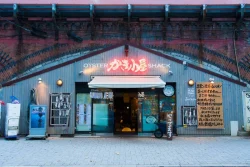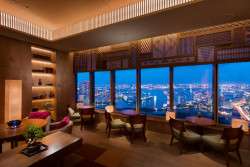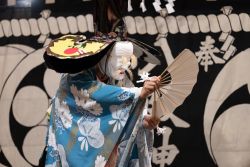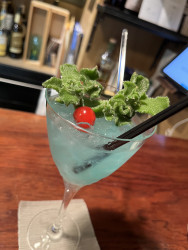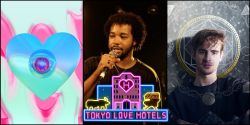
Originally published on metropolis.co.jp on December 2013

There’s no perfect translation for yurukyara, the Kumamons and Hikonyans of Japan. The kyara is short for “character,” but the yuru part seems to be designated a different English word by everyone who tries: Weak? Soft? Gentle? None of them really fit. Perhaps the closest word we have is mascot, but suggest that to any English-speaking Japanese person and they’ll furrow their brow and inhale sharply, as though trying to suck the word right out of the air to avoid anyone else hearing your misguided attempt.
Much like their name, the concept of yurukyara doesn’t really translate to other cultures, this need for all-smiles all the time, for everything to be embodied by happy bears and cats in helmets. Their presence has seeped throughout the fabric of Japanese society and bled into more serious aspects of life where they simply don’t belong, like glitter from a Halloween costume still making an appearance on your work clothes in December.
The most recent example of this mascot mania is Ashikawa Prison’s adoption of two six-foot cuddly characters to welcome convicts into incarceration. Human rights campaigners protested that harsh prison conditions were being masked by Katakkuri-chan, whose giant smiling face is topped with a purple flower, but a spokesperson explained their creation was necessary to reinforce the facility’s image as a rehabilitation institution that is connected to, and supported by, society. The underlying message was clear: regardless of any seemingly conflicting role, organizations don’t consider themselves part of modern Japanese society without a yurukyara to represent them.
The reason for their saturation of anything and everything, besides bored office workers looking for something other than administrative duties to do, seems to be the overwhelming success of regional yurukyara in promoting tourism.
The undeniable star of the past few years has been Kumamon, Kumamoto’s rosy-cheeked black bear. The winner of 2011’s Yurukyara Grand Prix and a household name in Japan, his fictitious evil alter ego has even made him into an international meme. Any English language internet search for Kumamon results in a number of pictures of him, arms held aloft in joy as he does things, “For the glory of Satan!”
Of course, in real life he spends his time dancing, waving his arms around and getting irrationally excited about things rather than carrying out satanic rituals. It’s unclear what exactly drives his popularity, but his unpredictabilty seems to play more of a part than his rather unremarkable appearance. Even Kumamon’s trademark “vague” expression—raised eyebrows and mouth slightly agape—looks strangely off. More akin to shock and confusion, as though he’s gradually developing self-awareness partway through the performance of an embarrassing dance routine.
One factor that goes part way to explaining his prevalence is Kumamoto’s relatively lax control of his image rights, which also contributed to a staggering ¥30 billion (USD $305 million) of merchandise sales last year. To put that figure into perspective, it’s $63 million more than Barbie merchandise generated in North America during the same period and equivalent to 0.6% of Kumamoto Prefecture’s entire annual GDP.
With this kind of money attainable it’s no surprise every prefecture, city and ward wants their own Kumamon. Even the bafflingly high ¥5 million spent on producing Nara’s Sento-kun was a pittance compared to the estimated ¥1.5 billion worth of PR his controversy generated.
Though yurukyara are often designed by public competition winners, there’s little variation in their composition. The vast majority are a basic anthropomorphic combination of the area’s notable characteristics and a name to match (though choosing a name isn’t always so simple, just ask Fukushima Industries’ Fukuppy). For example, Yubari is famous for Yubari melons and bears, hence Melon-kuma, a part-melon, part-bear, all-terrifying monstrosity which regularly makes children cry and hide behind their parents.
Another mishmash mascot of note is Sento-kun, whose disconcerting appearance combines Nara’s prominent temples and deer to result in a young monk with antlers. Again, children cried, one Buddhist group branded it “insulting” and locals were even more disparaging, claiming that it had committed the utmost of mascot sins: that of not being cute. So repulsed were they by this deformed little boy, the people of Nara sent over 600 of their own designs in an effort to replace him.
It’s debatable whether the professional designers responsible had an incredible amount of foresight or none at all, but the controversy lifted Sento-kun up by his awkward antlers and placed him at the forefront of national attention. Five years on, he remains one of the most well-known and begrudgingly likeable mascots in Japan.
For areas without the extravagance of multiple things to boast about, creating a mascot is often a simple case of adding limbs to their famed product or tourism spot. Kodaira City, producer of blueberries, has a lip-licking blueberry named Burubeh, and an onsen egg called Wakutama-kun represents the hot spring resort of Wakura Onsen.
Of course, some places are unfortunate enough to have absolutely nothing of note to brag about in the form of a giant colorful costume. If these places absolutely insist on having a mascot—and they always do—they’re left to either come up with something completely unconnected or actively search for inspiration. Nishi-Kokubunji’s Nishiko-kun, which looks like a giant gray lion pendant on legs, is a perfect illustration of the second route. His creator was walking around Musashi-Kokubunji when he came across an old stone roof with a lion pattern. In classic mascot-creating tradition, he added legs and Nishiko-kun was born.
The southern prefecture of Shimane, has taken an admirably honest—and opposite—approach to the process. Often ranked bottom of “Japan’s best prefecture” lists, it bravely decided to make this the prominent feature to promote, riffing on the established rules of yurukyara culture. Yoshida-kun, a scowling boy adopted from the area’s popular anime Eagle Talon, pokes fun at the area’s unpopularity on a number of souvenirs. One cake box proclaims, “At least Shimane has decent cake,” while a pack of chocolate pies sports in big bold characters: “Shimane or Tottori, I’m not really sure which but I went to that area.”
Japanese Idol
By Edward Harrison

Japan’s history and religion are steeped in icons and characters. In traditional Shinto belief, spirits or gods exist in everything from animals to nature and even in nonliving objects. Buddhist images such as the red-bibbed jizo statues and the Seven Lucky Gods are commonplace. Even Japanese mythical creatures called yokai appear in 3D form. All these graphic representations of characters can be seen as a precursor to the modern mascot and indicative of why characters are so prevalent in Japan.
With the many slick and polished characters used in advertising, anime and computer games; the loose and often awkward yurukyara have a unique charm: their un-sophistication. They often appeal to people who might normally be suspicious of characters’ motives. Yurukyara are undemanding, their naivety makes you feel relaxed and more open to whatever they might be promoting. Here are a few of our own faves.
Takamaru-kun

To celebrate its 400th anniversary, Hirosaki Castle created the badass Takamaru-kun. The area was once called Takaoka because of the taka (falcons) that live there, but it was renamed to Hirosaki in 1603. Takamaru-kun is wearing a kabuto (helmet) that combines the shape of the castle and the helmet worn by Tsugaru Tamenobu, the first lord of the area who drafted the design of the fortress.
Unari-kun

Narita is well known for its international airport, but it’s also famous for the large number of unagi (eel) restaurants. In the past, the small city had a flourishing locally caught eel trade. Now, however, the busiest airfreight hub in Japan is more likely to have the slippery creatures flown in from either Taiwan or China. Unari-kun is said to be from Unari planet: he flew to earth and searched for the best airport in world. After discovering Narita, he decided to settle there and as way of thanks to the friendly citizens he now promotes the city.
A!kanbe

A mascot for Nakatsu castle in Kyushu, A!kanbe might look like a slightly mental upside-down miso bowl but he is, in fact, modeled on a kabuto—specifically, the one worn by Kanbei Kuroda who first started building the stronghold. His expression and name also come from the word akanbe, a childish Japanese gesture. To do it, use one finger to press just below your eye and pull down while sticking out your tongue and making the sound, “Behhhhhhh.”
Funassyi

The unofficial mascot of Funabashi, Chiba had humble beginnings. Armed with a homemade costume and plenty of yaruki (motivation) this now international star is more famous (and possibly richer) than his kigurumi-clad compatriots. One of the few yurukyara that talks, he squeals and finishes each sentence with, “Nashiiii!” This smarter-than-your-average pear-shaped prodigy runs, jumps and shakes like a tazered would-be bag-snatcher. He jetted off to London recently, and was also the unfortunate victim of a prank involving the setting off of multiple explosions. His high-pitched voice and strange mannerisms make him a point of ridicule, but at the same time he’s just one of those characters you have to like.
Yurukyara Grand Prix

The Yurukyara Grand Prix was started in 2010 as annual competition for people’s favorite characters with the first one receiving just 169 entries and 240,000 votes. In 2011, Kumamon won in a landslide victory over 349 other contenders with 3, 330,000 people voting. In the 2012 competition, over 6.6 million voters chose Ehime’s Imabari city mascot, Barii-san, from 865 entrants. This year’s competition was held on November 24 at the Yurukyara Summit in Saitama and received 17,430,533 votes for 1,580 entrants. Here’s how it all went down:
1. Sanomaru of Tochigi
2. Shissedaimyo Ieyasu-kun of Shizuoka
3. Gunma-chan of Gunma
4. Fukka-chan of Saitama
5. Yoichi-kun of Otawara, Tochigi
6. Ayukoro-chan of Atsugi, Kanagawa
7. Choruru of Yamaguchi
8. Kawarimi Senbei of Fukuoka
9. Shippei of Iwata, Shizuoka
10. Shimanekko of Shimane (pictured, right)
Burubeh: Courtesy of Kodaira City Promotion Office; Sento-kun: Courtesy of Edward Harrison; Nishiko-kun: ©nishikokun, Designer: Yumi Nishio; Yoshida-kun: © Dream Link Entertainment, Inc; Wakura Onsen Wakutama-kun: © Wakura Onsen Tourism Association; Takamaru-kun, Unari-kun, a!kanbe, Shimanekko: Courtesy of Edward Harrison
